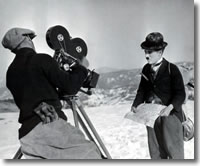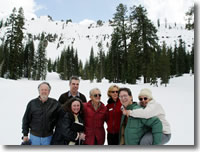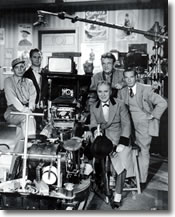Chasing Chaplin
by David BunkerSierra Sun, April 22, 2005
 High on the slopes of Sugar Bowl Ski Resort, Jack Totheroh, 90, stepped gingerly from the idling snow cat. Holding a faded black and white photograph in front of his eyes, he squinted against the stark winter sun and matched the picture with the snowy cliffs in the distance.
High on the slopes of Sugar Bowl Ski Resort, Jack Totheroh, 90, stepped gingerly from the idling snow cat. Holding a faded black and white photograph in front of his eyes, he squinted against the stark winter sun and matched the picture with the snowy cliffs in the distance.
Eighty-one years after his father, Rollie Totheroh, came to Truckee to film Charlie Chaplin in “The Gold Rush,” Totheroh made it to the location of the opening scene of the movie.
“The Gold Rush” opens with a line of hundreds of fortune seekers climbing a rugged mountain pass—what today is known as the Palisades at Sugar Bowl. The shot, which includes a tent and cabin village, was groundbreaking for 1924.
“It was considered to be one of the most outstanding feats in terms of logistics,” said David Totheroh, Rollie Totheroh’s grandson.
Extras from the streets
One of the essential ingredients to the opening sequence was a lot of extras willing to scale the Palisades. The film crew found their answer on the streets of Sacramento.
“They brought in three carloads of hobos from Sacramento,” Totheroh said. “They got to spend the day with the king of all tramps—Charlie Chaplin.”
In the end the dramatic opening sequence was one of the few shots that made the final cut into the film after months of winter shooting. Chaplin and Rollie Totheroh grew tired of the uncomfortable filming conditions, and eventually bolted to a studio in Southern California to finish the film.
“Chaplin and my grandfather were not that happy about working in the cold weather,” David Totheroh said. “This was a tough gig.”
Hunting down history
For Jack Totheroh, his son David Totheroh, and a few fellow film buffs, standing on the same ground Chaplin used as a set for his film was the crowning moment of a weekend trip that closely mirrored Chaplin’s journey 81 years ago. The group rode the train, stayed at the East River Inn—where it is rumored Chaplin lodged—and spent time on Donner Summit retracing filming locations.
The facts of Chaplin’s stay have grown scarce over the intervening eight decades. Truckee legends grew, often intertwined with the facts of the “Little Tramp’s” stay in town, said David Totheroh.
What is known is that Chaplin stayed for parts or all of February through April of 1924 to film “The Gold Rush.”
In their visit to Truckee, the Totherohs relied on photographs, letters and other verifiable evidence to track down Chaplin’s steps. Even after visiting the Truckee Donner Historical Society and Donner Summit resident Norm Sayler, an avid collector of Donner Summit history, not all of the group’s questions were answered.
Matching locations
 But using three photographs, they tracked down the exact location where Chaplin stood posing for the three shots in the movie. Apart from the opening movie shot, they found the locations of scenes where a windblown Chaplin stood on the flank of Mount Lincoln and a slope Chaplin slid down near a volcanic outcropping.
But using three photographs, they tracked down the exact location where Chaplin stood posing for the three shots in the movie. Apart from the opening movie shot, they found the locations of scenes where a windblown Chaplin stood on the flank of Mount Lincoln and a slope Chaplin slid down near a volcanic outcropping.
In the hunt for these film locations, the party used a intimate knowledge of Chaplin films. But even that is not as useful as a “sixth sense,” said Bonnie McCourt, David Totheroh’s girlfriend who has been on Chaplin film location searches across the state. And McCourt said that Gerald Smith, a longtime Chaplin fan who pointed out the slope that they believe Chaplin slid down 81 years ago, has exactly that sense.
“The man has radar,” McCourt said.
A Chaplin cameraman
 Rollie Totheroh was Chaplin’s cameraman for 38 years, a tenure unheard of in the film business then or now. Their relationship, which began in 1916 ended in 1953, when Chaplin was discouraged from returning to the United States by a Federal Bureau of Investigation paranoia over communism at the time. Chaplin, seeing the writing on the wall, went into self-imposed exile in Switzerland.
Rollie Totheroh was Chaplin’s cameraman for 38 years, a tenure unheard of in the film business then or now. Their relationship, which began in 1916 ended in 1953, when Chaplin was discouraged from returning to the United States by a Federal Bureau of Investigation paranoia over communism at the time. Chaplin, seeing the writing on the wall, went into self-imposed exile in Switzerland.
“As far as I know there is no film actor/ cinematographer relationship that has lasted as long,” David Totheroh said.
David Totheroh, who now lives in Rollie Totheroh’s old home in Southern California, remembers sitting by his grandfather as a child and soaking in stories of Chaplin, the Prohibition and the bitter cold of a little town called Truckee.
Times change
Descending Sugar Bowl in a snowcat provided by the ski resort, the group took one last glance up the hill. Alongside the black and white photos of Chaplin and Rollie Totheroh, the mark of change over the last 81 years was clear. Skiers and snowboarders zipped by spots that were once a stage for one of the world’s greatest comedians.
For Jack and David Totheroh the weekend was a way to reconnect with their memories, and retrace the steps of the “Little Tramp” on the anniversary of the day he was shooting.
“We are here on the day these shots were taken,” David Totheroh said.
Roland H. "Rollie" Totheroh (November 29, 1890 – June 18, 1967)
Rollie Totheroh worked as Cinematographer on Charles Chaplin's movies for over thirty years from the earliest Mutual years in 1915 to Monsieur Verdoux (1947). Totheroh was instrumental in filming all of Chaplin's masterpieces, including The Kid (1921), The Gold Rush (1925), City Lights (1931), Modern Times (1936) and The Great Dictator (1940). Totheroh was the man with whom Chaplin had the longest working relationship, other than with his Chaplin's brother Sydney Chaplin.
Totheroh was born in San Francisco and before becoming a cameraman for Essanay studios in Niles, California, he worked as a newspaper illustrator. Totheroh also played minor league baseball for a time. According to a Totheroh family story, Rollie and Charlie first met on a baseball field outside of the Essanay Studios. Totheroh appeared in a few early silent films as an actor as well.
Chaplin & Totheroh – Image Credits: All images from Chaplin Archives, Switzerland
